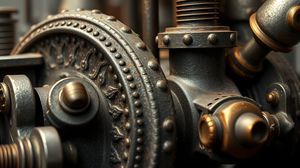
Eastbury Manor House in Barking is a striking example of Tudor architecture, showcasing the grandeur of the 16th century. Built in the late 1500s, this Grade I listed building is not only a testament to architectural history but also offers a glimpse into the social and cultural fabric of the era.
The house was originally built for Clement Sysley, a wealthy merchant and courtier. Its brick construction was considered innovative at the time, reflecting the opulence and aspirations of the emerging gentry.
A fascinating feature of Eastbury Manor House is its wall paintings. Uncovered during the restoration work, these rare artworks give insight into the decorative tastes of the Tudor period and have been meticulously preserved for visitors to admire.
The tranquil gardens surrounding Eastbury Manor House provide a peaceful haven in the bustling borough of Barking. They are a perfect spot for visitors to enjoy a serene stroll while appreciating the historical setting.
One of its more curious features is the presence of a dovecote, indicating the importance of birds as a source of food and income during the manor's heyday. This small yet significant building adds another layer of historical intrigue to the site.
The historical significance of Eastbury Manor House extends to its social history, as it once played host to local meetings and ceremonies. Exploring this location offers a unique lens through which the everyday lives and societal norms of the past can be understood.
Eastbury Manor House encapsulates centuries of history within its walls, making it a unique and compelling visit for those interested in the evolution of London's landscape and society.

Making the Most of Your Visit:
Start your visit by noting the brickwork. Eastbury Manor House is one of the earliest examples of brick-built architecture in England, so paying attention to its craftsmanship can give you a real appreciation for the skill and innovation of the time.
Don't miss the hidden wall paintings. These rare Tudor artworks were uncovered during restoration and are a must-see to understand the decorative style of the period.
Take a leisurely stroll around the gardens. They're not only beautiful and peaceful, but they also offer unique views of the manor itself, giving you a different perspective of its historical architecture.
Be sure to explore the dovecote. It's a fascinating slice of history in itself, showcasing the role pigeons played in the household economics of the era. While it may not seem as grand as the house, it's equally intriguing.
Check out the house's event schedule. Throughout the year, Eastbury Manor House hosts various events that provide additional context to your visit, such as Tudor-themed events or local history talks.

Visiting Times & Costs:
Eastbury Manor House is open to the public at specified times. It is generally open from Thursday to Sunday.
Opening Hours:
- Thursday to Sunday: 10:00 AM - 4:00 PM
Admission Charges:
| Category | Price |
|---|---|
| Adults | £5 |
| Concessions | £3 |
| Children (under 16) | Free |
| National Trust Members | Free |
| Local Residents | Free on certain days; please check local announcements. |
Accessibility: Eastbury Manor House strives to be accessible to all visitors. There is wheelchair access to the ground floor, but due to the historic nature of the building, access to the upper floors is restricted. Assistance dogs are welcome.
Please note that hours and fees may vary during special events, and it is advisable to check for the most current information before planning your visit.

Address & Map:

Nearby:





